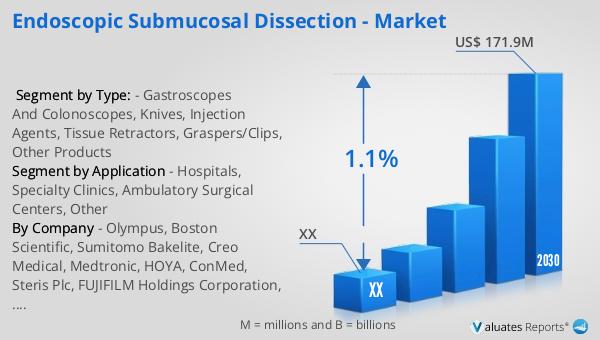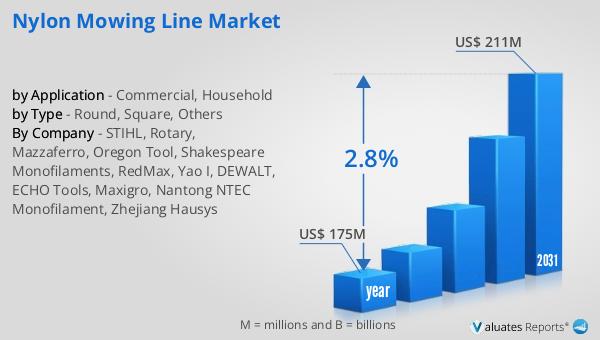What is Endoscopic Submucosal Dissection - Global Market?
Endoscopic Submucosal Dissection (ESD) is a sophisticated medical procedure primarily used to remove cancerous or precancerous lesions from the gastrointestinal tract. This technique is particularly valuable because it allows for the removal of lesions in a minimally invasive manner, preserving the surrounding healthy tissue. ESD is performed using an endoscope, a flexible tube equipped with a camera and specialized instruments, which is inserted through the mouth or anus to reach the stomach, esophagus, or colon. The procedure involves lifting the lesion from the submucosal layer, cutting around it, and then removing it entirely. This method is advantageous over traditional surgical techniques as it reduces recovery time, minimizes complications, and often eliminates the need for more invasive surgery. The global market for ESD is expanding as awareness of its benefits grows among healthcare providers and patients. The demand for ESD is driven by the increasing prevalence of gastrointestinal cancers and the need for effective, less invasive treatment options. As technology advances, the precision and safety of ESD continue to improve, making it a preferred choice in many medical settings worldwide.

Gastroscopes And Colonoscopes, Knives, Injection Agents, Tissue Retractors, Graspers/Clips, Other Products in the Endoscopic Submucosal Dissection - Global Market:
The global market for Endoscopic Submucosal Dissection (ESD) encompasses a range of specialized tools and devices essential for performing this intricate procedure. Gastroscopes and colonoscopes are fundamental to ESD, serving as the primary instruments that allow physicians to visualize and access the gastrointestinal tract. These scopes are equipped with high-definition cameras and channels through which various surgical tools can be passed. Knives used in ESD are specially designed to make precise cuts around the lesion. They come in different shapes and sizes, such as needle knives, insulated-tip knives, and hook knives, each tailored for specific types of lesions and anatomical locations. Injection agents are crucial in ESD as they are used to lift the lesion from the submucosal layer, creating a cushion that facilitates safer and more effective dissection. These agents often contain saline or other solutions that help in separating the lesion from the underlying muscle layer. Tissue retractors are employed to hold back surrounding tissues, providing a clear view and access to the target area. This is vital for ensuring precision and minimizing damage to healthy tissues. Graspers and clips are used to manipulate tissues and secure any bleeding vessels during the procedure. They play a critical role in maintaining hemostasis and ensuring the safety of the patient. Other products in the ESD market include electrosurgical generators, which provide the necessary energy for cutting and coagulating tissues, and hemostatic devices that help control bleeding. The development and refinement of these tools are driven by the need for greater precision, safety, and efficiency in ESD procedures. As the demand for minimally invasive treatments grows, the market for these specialized ESD tools is expected to expand, offering new opportunities for innovation and improvement in gastrointestinal cancer treatment.
Hospitals, Specialty Clinics, Ambulatory Surgical Centers, Other in the Endoscopic Submucosal Dissection - Global Market:
Endoscopic Submucosal Dissection (ESD) is increasingly being utilized across various healthcare settings, including hospitals, specialty clinics, ambulatory surgical centers, and other medical facilities. In hospitals, ESD is often performed in specialized endoscopy units equipped with the necessary technology and skilled personnel. Hospitals are typically the primary setting for ESD due to their comprehensive resources and ability to handle complex cases. They offer the advantage of multidisciplinary teams, including gastroenterologists, surgeons, and anesthesiologists, who can collaborate to ensure optimal patient outcomes. Specialty clinics, on the other hand, provide a more focused environment for ESD procedures. These clinics often cater to patients with specific gastrointestinal conditions and offer a more personalized approach to care. The use of ESD in specialty clinics is growing as these facilities invest in advanced endoscopic equipment and training for their staff. Ambulatory surgical centers (ASCs) are also becoming popular venues for ESD due to their efficiency and cost-effectiveness. ASCs offer a convenient alternative to hospital-based procedures, with shorter wait times and reduced costs for patients. They are well-suited for ESD as they can provide the necessary infrastructure and expertise while maintaining a focus on patient comfort and satisfaction. Other healthcare settings, such as private practices and research institutions, are also exploring the use of ESD as they recognize its potential benefits. These settings may offer ESD as part of clinical trials or specialized treatment programs, contributing to the growing body of evidence supporting its efficacy and safety. Overall, the adoption of ESD across diverse healthcare environments reflects its versatility and effectiveness as a minimally invasive treatment option for gastrointestinal lesions. As awareness of ESD continues to spread, more facilities are likely to incorporate this technique into their offerings, further driving its global market growth.
Endoscopic Submucosal Dissection - Global Market Outlook:
The global market for Endoscopic Submucosal Dissection (ESD) was valued at approximately US$ 141 million in 2023. It is projected to grow to a revised size of US$ 171.9 million by 2030, with a compound annual growth rate (CAGR) of 1.1% during the forecast period from 2024 to 2030. This growth is indicative of the increasing recognition of ESD as a valuable tool in the diagnosis and treatment of gastrointestinal conditions. ESD offers a minimally invasive alternative to traditional surgery, which is appealing to both patients and healthcare providers. The procedure's ability to effectively remove lesions while preserving healthy tissue makes it a preferred choice for treating early-stage cancers and other precancerous conditions. As the prevalence of gastrointestinal diseases continues to rise, the demand for effective and less invasive treatment options like ESD is expected to grow. Additionally, advancements in endoscopic technology and techniques are likely to enhance the precision and safety of ESD, further driving its adoption in medical practice. The market outlook for ESD reflects a positive trend towards more widespread use of this innovative procedure, as healthcare systems worldwide seek to improve patient outcomes and reduce the burden of invasive surgeries.
| Report Metric | Details |
| Report Name | Endoscopic Submucosal Dissection - Market |
| Forecasted market size in 2030 | US$ 171.9 million |
| CAGR | 1.1% |
| Forecasted years | 2024 - 2030 |
| Segment by Type: |
|
| Segment by Application |
|
| By Region |
|
| By Company | Olympus, Boston Scientific, Sumitomo Bakelite, Creo Medical, Medtronic, HOYA, ConMed, Steris Plc, FUJIFILM Holdings Corporation, MTW Endoskopie Manufaktur, Ovesco Endoscopy AG, Zeon Medical Inc., Micro-Tech Endoscopy, Karl Storz SE & CO. KG, Cook Medical, Leo Medical Co, Erbe Elektromedizin GmbH, Taewoong Medical Co., DCC Healthcare Limited, Kossen Co., INNOVAMEDICA S.p.A., Jiangsu Vedkang Medical Science and Technology Co., Ltd., Hangzhou AGS Medical Technological, Beijing ZKSK Technology Co., Ltd. |
| Forecast units | USD million in value |
| Report coverage | Revenue and volume forecast, company share, competitive landscape, growth factors and trends |
